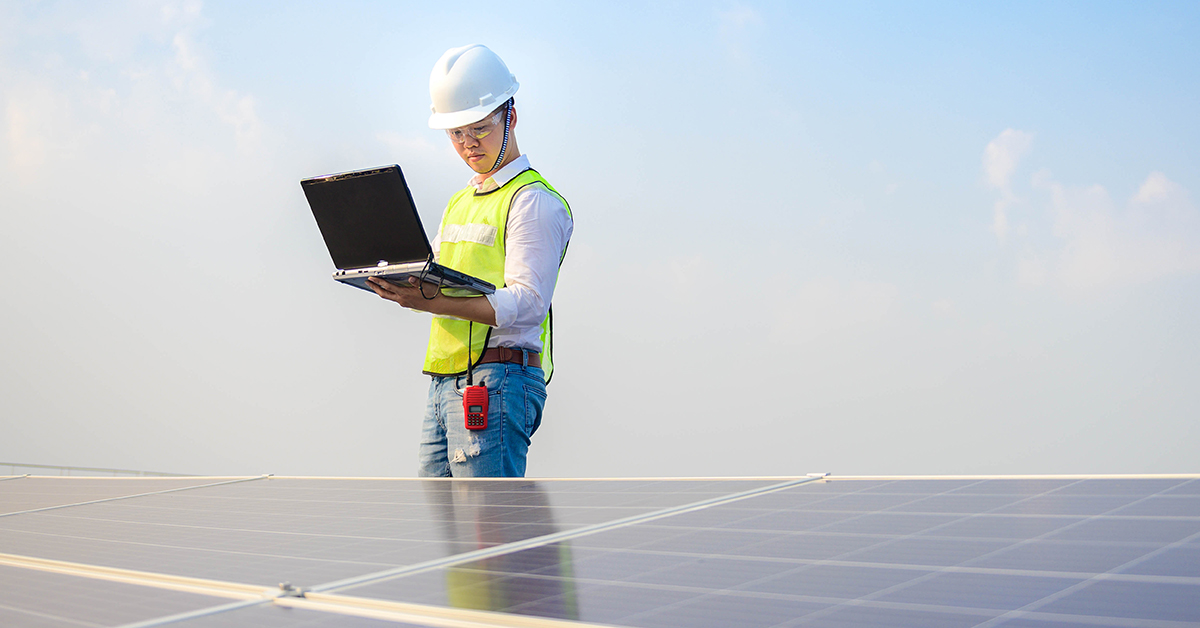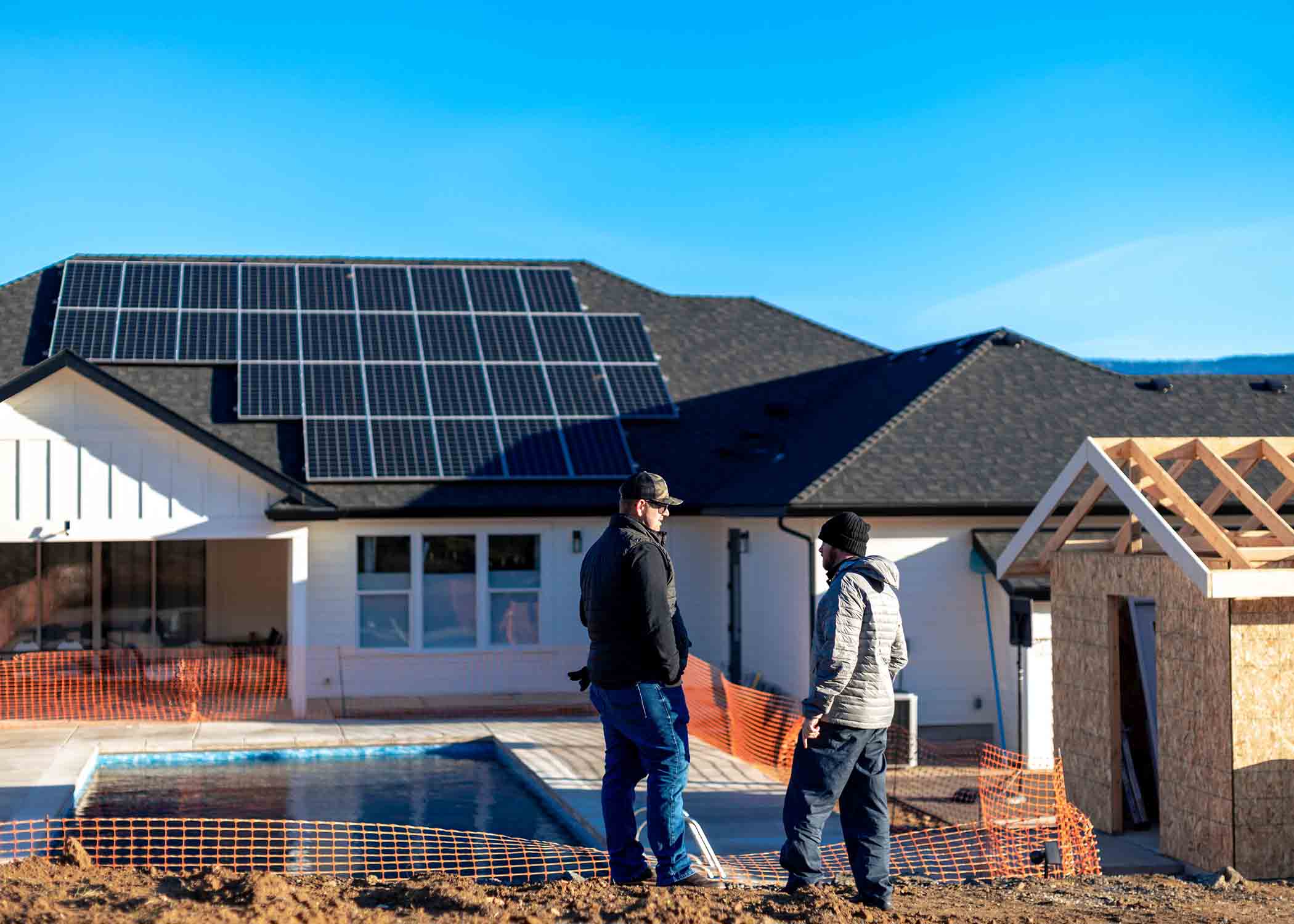How Many Solar Panels Do You Need To Power Your Home?
Your energy usage in kilowatt-hours (kWh) dictates the size of your system. Panels have a broad range of wattages (275W-360W is common as of early 2019), and other factors like local sun exposure, mount orientation and the presence of a battery bank also play a part. Read this article and use our solar cost calculator for help finding an accurate estimate.
One of the most common questions our design technicians get is: “How many solar panels do I need?”
The answer is pretty complex, and frankly, most people approach it from the wrong angle when they start to look into solar.
We’re often asked to quote a system to power a 3-bedroom home or support a family of 4. In these situations, it’s impossible to provide an accurate estimate until we know more about the household’s energy needs.
In reality, the best place to start is to evaluate your current energy use based on past electric bills. Past usage data is the best baseline to figure out how many panels you will need.
Lifestyle, climate and panel efficiency all play a role in figuring out the size of your solar system. Here’s the process we use to make an accurate estimate.
How many panels for grid-tied systems?
In order to figure out just how many panels you need, you’ll want to gather up 6 months to a year’s worth of electric bills. If you live in an area with snowy winters or blistering hot summers, look at a larger sample of bills to understand when your usage spikes. Take peak periods into account as you estimate how many panels you’ll need to cover your energy usage.
Some companies provide a 12-month summary of how much electricity you use on every bill. Depending on your utilities provider, you may just need one bill to find an estimate for the year.
Got your paperwork in order? Great – you want to look for how many kilowatt hours (kWh) of electricity you use per year.
Wait, what’s a kilowatt hour?
A kilowatt hour (kWh) is a measurement of energy. If an appliance rated for 1 kilowatt (1000W) runs for an hour, then one kWh of energy has been used.
The energy company measures total energy usage in kilowatt hours. Your total usage in kilowatt hours determines how much you are billed each month.
Example 1: A fridge rated at 250 watts runs for 4 hours per day. 250W x 4 = 1000W, or 1 kW. This fridge uses 1 kWh of energy over the course of a day.
Example 2: An oven is rated at 2000 watts (2 kW). Cooking in this oven for half an hour would consume 1 kWh of power (2kw x 0.5 hours = 1kWh).
Find how many kWh of energy you use per year. That will give you a good jumping off point for estimating your energy needs – but you’re not there yet.
Divide that number by 365 to get your daily energy usage in kWh.
Once you have your daily energy usage, use this formula to estimate your total system size:
Daily Usage (kWh) ÷ Sun-Hours ÷ 0.9 inefficiency factor = Minimum Solar Array Output
Sun-hours refers to how much sun you get each day where you live. You can find that info on our US sun-hours map. More on this a bit later.
The inefficiency factor simply accounts for circumstances that would make your system run below its optimal output, like shade, extreme temperatures, voltage drop and equipment inefficiencies.
Take your daily usage and divide it by these two numbers to get an estimate of the overall output of your system.
For example:
According to the U.S. Energy Information Administration, the average American household used 10,766 kWh of electricity annually in 2016. That’s about 29.5 kWh per day.
Let’s say you live in Arizona, which gets 5.5 sun-hours per day.
29.5 kWh per day ÷ 5.5 sun-hours ÷ 0.9 = 5.9595 kW capacity system.
That would give you an approximate system size of 5.96 kW, or 5959W (remember, 1 kilowatt = 1000 watts).
From there, the last step is to divide by the energy rating of each individual panel. Solar panels are graded by how much power they use. The panels you would use in a residential setting typically range from 275 to 350 watts per panel.
Let’s say we want to use Astronergy 335W panels. Take your system size and divide by the panel wattage to figure out how many solar panels you need in your system:
5959W ÷ 335W = 17.78 panels
Round up the final number, since you can’t buy partial panels. In this scenario, we would need 18
We can’t stress this enough: this calculation is a very rough estimate. It should only be used to ballpark system size and make early pricing estimates.
But don’t take this estimate as gospel – there are too many factors that can change the size of your system in practice.
Additional considerations for off-grid systems
Calculating power consumption needs for an off-grid system is a tad more complicated. People who live off-grid need to focus on daily power usage rather than monthly or annual consumption.
You’re not staring down a power bill each month – you’re independent and responsible for covering your own day-to-day power needs. The system needs to be able to produce enough (and store enough) to keep things running smoothly.
Without power bills as a starting point, it’s best to start by listing out your major appliances and estimating how much you use them on a daily basis. Input this list into our Load Evaluation Calculator.
If you’re not sure how much power an appliance uses, follow the appliance electrical consumption table as a guide. You can also check for the EnergyGuide sticker, or use a meter to measure energy consumption if possible.
This form will give an estimated daily usage.
Pay close attention to December and January when you estimate your energy needs. Those months tend to have the highest power usage and the lowest output by your system.
When you live off-grid, you will need a battery system that’s large enough to store enough power for the day and then use solar power to recharge them in a timely manner. It’s common to lean on a backup generator during the winter, when there won’t be enough sunlight to fully power your solar system.
Once you know how much power you use in kWh per day, a solar design technician can determine the minimum battery size needed with a formula that accounts for things like inefficiencies and temperature coefficients.
Here are the basic formulas we use to size off-grid systems:
Minimum Battery capacity (for lead acid batteries):
Daily usage (kWh) x 2 for a 50% discharge depth x 1.2 inefficiency factor = Minimum Battery Capacity
Minimum Solar Array Size
Daily usage (kWh) ÷ Sun-hours ÷ .9 inefficiency factor = Minimum Solar Array Output*
*Ensure solar array meets battery charge requirements, typically around 10 charging amps per 100ah battery capacity.
You may need a larger array or battery bank based on your location, ambient temperature, your usage patterns and other factors. Take a look at our Battery Bank Sizing Calculator to help figure out how many batteries you need to power your system.
Factoring in sun-hours based on your location
“Sun-hours” refers to how much solar energy hits a given area over a certain amount of time.
Your local climate determines how many peak sun-hours you get each day. This number can change drastically based on where you live. If you live in the United States, you can check out our Solar Insolation Map to get an estimate of how many sun-hours you receive in your area.
It’s important to keep in mind that the term “sun-hours” doesn’t just refer to the hours of daylight that your area receives. The peak hours occur when the sun is at its highest in the sky, which will change based on the season and how close you are to the equator. In the winter, the average sun-hours in your location could decrease by 25% to 50%.
So how do sun-hours affect the number of panels on your solar system? If you live in an area with less sun-hours, you’ll need more panels to capture what you need to cover 100% of your energy usage. However, if you live in an area that gets 5-6 sun-hours per day, you might be able to get by with a smaller system.
Quality vs. quantity: panel efficiency isn’t everything
Another aspect that affects the size of your system is the efficiency of the solar panels themselves. Most residential panels range from 275W to 360W. If you go with a
When it comes to solar, efficiency isn’t always the most important factor to consider when you build your system. It really depends on what your specific goals are.
For example, if you look at your solar panels primarily as an investment and a quick ROI is your biggest goal, you might be better off with a lower output, lower cost panel.
“If a panel is 50% more efficient, but costs 100% more, you’re better off paying for [a larger system] of less efficient panels.”
-Brady Schimpf, technical marketing engineer at Ironridge
Brady Schimpf, technical marketing engineer at Ironridge, he had a few thoughts on this matter. He said one of the most common mistakes he sees people make is that they buy into ultra-efficient, high-quality, and technically advanced system, and it might not be worth it – especially if ROI is your biggest concern.
“While a lot of the proprietary systems like that have really good equipment, it is important to look at the cost per watt,” he explained. He urges consumers to consider this: “How much are you paying for the total wattage/production of the system?
“It doesn’t really matter how efficient a panel is if it costs a lot more. If a panel is 50% more efficient, but costs 100% more, you’re better off paying for [a larger system] of less efficient panels.”
But there are some circumstances where having a smaller yet more efficient solar system makes sense. For example, if your roof space is really limited, you might need a more efficient system to cover your energy needs within that given area.
Compare: Astronergy 280W panels vs. Mission Solar 360W panels
Considering other variables when designing a solar system
We can’t stress this enough: this breakdown only serves as a very rough estimate and a starting point for planning your system.
It’s great to get you closer to a ballpark figure on the cost of panels. It will help as a benchmark when you measure your roof to see if you can fit a system up there.
But when you get deeper into planning your system, unexpected hurdles always come up and the system size tends to change.
What if you decide to go with 275W panels instead of 350W panels because the cost-per-watt is lower? What if shade covers your system, or your roof doesn’t directly face the sun? What if harsh weather causes your equipment to perform below its rated efficiency? What if you start using more energy than you did in the past?
Yup . . . you’ll need more panels.
Although this breakdown can give you an estimate of how many solar panels you’ll need in your array, at the end of the day it’s just an estimate. There are several other variables that can determine the size of your solar system, but this process is still important as it gives you an idea of what to look for before you seek out quotes on solar systems.
If you’re interested in going solar, the best thing you can do is speak with a solar design technician that can help you find the ideal system for your unique situation. Bring your estimate as a starting point. We’ll go over any potential problems and tweak the design to suit your location and lifestyle.




